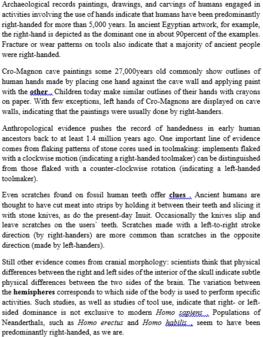* Read the following passage and mark the letter A, R, C, or D on your answer sheet to indicate the correct answer to each of the questions from 24 to 30.
People have been donating blood since the early twentieth century to help accident victims and patients undergoing surgical procedures. Usually a pint of whole blood is donated, and it is then divided into platelets, white blood cells, and red blood cells. People can donate blood (for red blood cells) about once every two months.
Transfusing the blood from the donor to the recipient is straightforward. It involves taking the blood from a donor’s arm vein by means of a hypodermic syringe. The blood flows down from the container by gravity. This is a slow process and may last as long as 2 hours to complete the infusion of blood into the recipient. The patient is protected from being infected during the transfusion. Only sterile containers, tubing, and needles are used, and this helps ensure that transfused or stored blood is not exposed to disease causing bacteria.
Negative reactions to transfusions are not unusual. The recipient may suffer an allergic reaction or be sensitive to donor leukocytes. Some may suffer from an undetected red cell incompatibility. Unexplained reactions are also fairly common. Although they are rare, other causes of such negative reactions include contaminated blood, air bubbles in the blood, overloading of the circulatory system through administration of excess blood, or sensitivity to donor plasma or platelets.
Today, hospitals and blood banks go to great lengths to screen all blood donors and their blood. All donated blood is routinely and rigorously tested for diseases, such as HIV, hepatitis B, and syphilis. When the recipient is a newborn or an infant, the blood is usually irradiated to eliminate harmful elements. Donated blood is washed, and the white blood cells and platelets removed.
Storing the blood sometimes requires a freezing process. To freeze the red blood cells, a glycerol solution is added. To unfreeze the, the glycerolis removed. The ability to store blood for long periods has been a boon to human health.
The word "it" refers to___________.
A. surgical procedures
B. accident victims
C. a pint of whole blood
D. surgery patients



ĐÁP ÁN C
Câu đề bài: Từ “nó” đề cập đến_______________
Đáp án C. một pint máu thuần chủng
Các đáp án còn lại:
A. quy trình phẫu thuật B. nạn nhân tai nạn
D. bệnh nhân phẫu thuật
Thông tin trong bài:
Usually a pint of whole blood is donated, and it is then divided into platelets, white blood cells, and red blood cells.
Thường thì một pint máu thuần chủng được hiến, và rồi nó được phân chia ra thành tiểu cầu, bạch cầu và hồng cầu.
—> It = nó ở đây là một pint máu nguyên, chưa được phân tách.